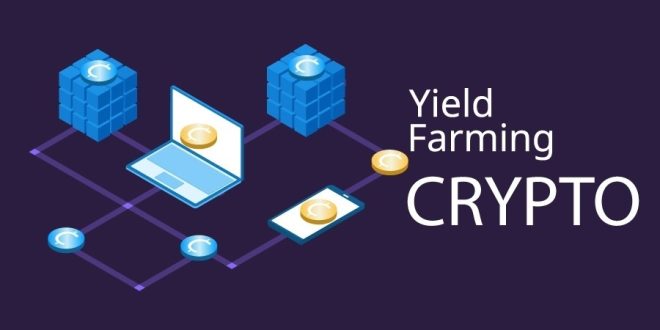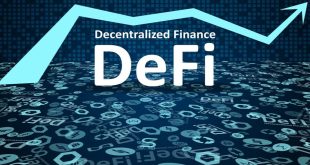Yield farming and DeFi lending have emerged as popular ways to earn passive income in the world of cryptocurrencies and blockchain technology. With the rise of decentralized finance (DeFi), individuals can now participate in financial activities traditionally performed by banks and other intermediaries. This article explores the concepts of yield farming and DeFi lending, explains how they work, and provides insights into maximizing returns in these practices.
Introduction to Yield Farming and DeFi Lending
In recent years, the decentralized finance ecosystem has witnessed significant growth and innovation. Yield farming and DeFi lending are two key components that have gained considerable attention. Yield farming involves leveraging various DeFi protocols to maximize returns on cryptocurrency holdings. On the other hand, DeFi lending allows users to borrow and lend digital assets without intermediaries.
What is Yield Farming?
Yield farming is a practice within the decentralized finance (DeFi) ecosystem that allows cryptocurrency holders to earn passive income or “yield” on their digital assets. It involves leveraging various DeFi protocols and platforms to optimize the returns on cryptocurrency holdings.
In yield farming, participants provide liquidity to decentralized exchanges or lending platforms by depositing their cryptocurrency assets into liquidity pools. These liquidity pools facilitate transactions and enable the smooth functioning of the DeFi ecosystem. In return for providing liquidity, participants receive rewards in the form of additional tokens or fees generated by the protocol.
How Yield Farming Works?
Yield farming involves depositing cryptocurrency assets into liquidity pools or protocols and earning rewards in the form of additional tokens. These rewards can come from transaction fees, newly minted tokens, or other mechanisms implemented by the protocol. By providing liquidity to these platforms, users contribute to the ecosystem and are rewarded accordingly.
Risks Associated with Yield Farming
Here are some of the key risks associated with yield farming:
- Impermanent Loss: Impermanent loss is a risk specific to providing liquidity in automated market maker (AMM) protocols. It occurs when the value of the assets in the liquidity pool changes compared to holding them individually. Depending on market conditions, participants may experience temporary losses when compared to simply holding the assets without providing liquidity.
- Smart Contract Vulnerabilities: Yield farming relies on the use of smart contracts, which are susceptible to coding errors or vulnerabilities. In the event of a smart contract exploit or hack, funds locked in the contract may be at risk of theft or loss. It is crucial to thoroughly assess the security measures, auditing reports, and track record of the platform or protocol before engaging in yield farming.
- Market Volatility: The cryptocurrency market is known for its volatility, and yield farming is not immune to market fluctuations. The value of the assets being farmed can change rapidly, affecting the overall returns. Participants should be prepared for potential losses or reduced yields due to market volatility.
What is DeFi Lending?
DeFi lending, short for decentralized finance lending, is a financial ecosystem within the world of cryptocurrencies that allows individuals to lend and borrow digital assets without the need for intermediaries like banks or traditional financial institutions. It leverages blockchain technology and smart contracts to enable peer-to-peer lending and borrowing on a global scale.
In DeFi lending, participants can act as lenders or borrowers, interacting directly with lending platforms or protocols.
Benefits of DeFi Lending

Here are some of the key advantages of DeFi lending:
- Global Accessibility: DeFi lending operates on blockchain technology, which enables global access without the need for traditional intermediaries. Anyone with an internet connection can participate in DeFi lending, regardless of their geographical location, opening up financial opportunities to a broader range of individuals.
- Elimination of Intermediaries: Traditional lending typically involves multiple intermediaries, such as banks, which can introduce delays, additional costs, and potential privacy concerns. DeFi lending removes these intermediaries by leveraging smart contracts, enabling peer-to-peer lending directly between borrowers and lenders. This streamlines the lending process, reduces costs, and enhances efficiency.
- Transparency and Audibility: DeFi lending platforms are built on public blockchains, providing transparency and immutability. Every transaction and interaction within the lending protocol is recorded on the blockchain and can be audited by anyone. This transparency fosters trust and helps ensure the integrity of the lending process.
- Competitive Interest Rates: DeFi lending offers competitive interest rates compared to traditional financial institutions. Through the elimination of intermediaries and automated processes facilitated by smart contracts, DeFi lending platforms can provide attractive interest rates for lenders while offering borrowers access to funds at more competitive rates.
- Flexibility and Customization: DeFi lending platforms often offer a range of customizable options for both borrowers and lenders. Borrowers can select the loan terms that suit their needs, such as loan duration and collateral requirements. Lenders, on the other hand, have the flexibility to choose the assets they want to lend and the interest rates they wish to earn.
Risks of DeFi Lending
Here are some of the risks associated with DeFi lending:
- Smart Contract Vulnerabilities: DeFi lending platforms operate using smart contracts, which are self-executing contracts with the terms of the agreement directly written into code. However, smart contracts can have vulnerabilities or coding errors that hackers may exploit, leading to the loss of funds or manipulation of the lending protocol.
- Liquidity Risks: DeFi lending relies on the availability of liquidity within the platform. If there is insufficient liquidity or a sudden withdrawal of funds from the lending pools, it can lead to delays in loan repayment or even the inability to withdraw funds. Users should consider the liquidity conditions of the platform and assess the risks associated with it.
- Counterparty Risks: DeFi lending involves interacting with anonymous participants in the ecosystem. While smart contracts facilitate trustless transactions, there is still a level of risk associated with counterparties defaulting on their loans or intentionally providing inaccurate collateral. Users should exercise caution and perform due diligence when selecting borrowers or lenders.
- Regulatory Uncertainty: The regulatory landscape surrounding DeFi lending is still evolving, and there may be uncertainties regarding compliance requirements and legal frameworks. Changes in regulations or government actions could impact the operations and viability of DeFi lending platforms, potentially leading to disruptions or closures.
- Market Volatility: The cryptocurrency market is known for its volatility, and this can affect the value of collateral provided by borrowers. If the collateral’s value drops significantly, there may be insufficient collateral to cover the loan, leading to potential losses for lenders.
Maximizing Returns in Yield Farming and DeFi Lending
To maximize returns in yield farming and DeFi lending, consider the following strategies:
Choosing the Right Platforms and Projects
Research various platforms and projects to identify those with a proven track record, strong communities, and audited smart contracts. Selecting reputable platforms increases the likelihood of earning consistent returns and minimizes the risk of potential scams.
Understanding the Token Economics
Tokens play a crucial role in yield farming and DeFi lending. Understand the tokenomics of the projects you engage with, including token supply, distribution mechanisms, and incentives for liquidity providers. This understanding allows you to make informed decisions and maximize your returns.
Strategies for Maximizing Returns
Explore different strategies, such as yield optimization tools, compounding, and staking rewards, to maximize your returns. Diversify your portfolio by allocating assets across various projects and platforms. Additionally, stay updated with the latest trends, developments, and opportunities in the DeFi space.
Managing Risks in Yield Farming and DeFi Lending
While pursuing high returns, it’s essential to manage risks effectively. Consider the following risk management techniques:
Diversification
Avoid putting all your assets into a single project or platform. Diversify your investments across different protocols, cryptocurrencies, and risk levels. This approach helps mitigate the impact of potential losses and provides a more stable income stream.
Due Diligence
Before engaging with any platform or project, conduct thorough due diligence. Review smart contracts, audit reports, community discussions, and the team behind the project. Assess the risks and potential rewards before committing your assets.
Monitoring and Adjusting Strategies
Stay vigilant and monitor your investments regularly. Evaluate the performance of your chosen platforms and projects. Adjust your strategies based on market conditions, project updates, and emerging opportunities. Flexibility and adaptability are key to success in the ever-evolving DeFi landscape.
Conclusion
Yield farming and DeFi lending offer exciting opportunities to maximize returns in the world of decentralized finance. However, it’s crucial to approach these practices with caution and a thorough understanding of the risks involved. By choosing reputable platforms, understanding token economics, diversifying investments, and staying informed, investors can navigate the DeFi landscape and unlock the potential for passive income.
FAQs
What is the difference between yield farming and DeFi lending?
Yield farming involves depositing cryptocurrency assets into liquidity pools and earning additional tokens as rewards. DeFi lending, on the other hand, allows users to borrow and lend digital assets, earning interest as lenders or accessing funds as borrowers.
Are yield farming and DeFi lending risky?
Yes, both yield farming and DeFi lending carry risks. Smart contract vulnerabilities, price volatility, and liquidity risks are some of the challenges users may face. Conducting due diligence and managing risks effectively are essential.
How can I maximize my returns in yield farming and DeFi lending?
To maximize returns, choose reputable platforms and projects, understand token economics, and diversify your investments. Stay updated with market trends and explore different strategies such as yield optimization and compounding.
Is DeFi lending available to everyone?
Yes, DeFi lending is accessible to anyone with an internet connection and digital assets. It offers global accessibility and eliminates the need for traditional intermediaries.
Where can I learn more about yield farming and DeFi lending?
You can explore reputable online resources, join crypto communities, and follow industry experts to stay informed about yield farming, DeFi lending, and the latest developments in the decentralized finance space.

I’m a highly experienced and successful crypto author who has helped thousands of people to invest in cryptocurrencies. I have a good knowledge and experience in the industry, and I have always been up-to-date with the latest developments. I’m a highly respected member of the crypto community, so if you are looking for someone to help you navigate the world of cryptocurrencies, then you can always contact me.
 Crypto Print
Crypto Print

